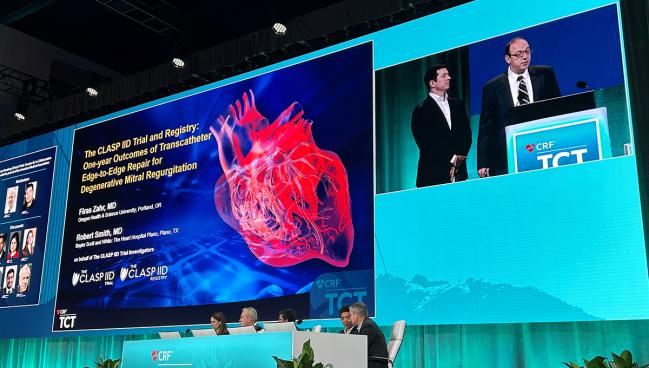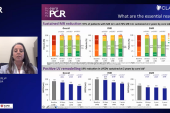CLASP IID at 1 Year: Good Results With Both Pascal, MitraClip for Mitral TEER
Operators have a choice of two devices, Neal Kleiman says. “I’m glad to see we’ve got a field that’s evolving and competitive.”

SAN FRANCISCO, CA—For patients with symptomatic degenerative mitral regurgitation (DMR) and a prohibitive surgical risk, transcatheter edge-to-edge repair (TEER) with either of two approved devices provides good—and comparable—results, according to 1-year follow-up of the CLASP IID trial.
With either the Pascal (Edwards Lifesciences) or the MitraClip (Abbott), patients had low rates of mortality and heart failure hospitalization, sustained improvements in MR and other echocardiographic measures, and continued gains in NYHA functional status and quality of life at the 1-year mark, similar to what was seen in the primary analysis of the trial with 6 months of follow-up.
Similar benefits were observed among Pascal-treated patients who did not qualify for randomization due to anatomic considerations and were included in an associated registry.
“The 1-year results really advocate for the advancement of mitral TEER as an important treatment option for prohibitive-surgical-risk patients with DMR and [affirm] the safety and efficacy of the Pascal system in this group,” said Robert L. Smith, MD (Baylor Scott & White The Heart Hospital – Plano, TX), who presented the findings here at TCT 2023 along with Firas Zahr, MD (Oregon Health & Science University, Portland, OR).
“Overall,” Smith added at a press conference, “the CLASP IID randomized trial and registry confirm the clinical and quality-of-life benefits from MR reduction with the Pascal system in a broad DMR patient population, including those patients who were deemed ineligible for randomization.”
The 1-year findings, published simultaneously online in JACC: Cardiovascular Interventions, provide more confidence that these two devices perform similarly, Neal Kleiman, MD (Houston Methodist DeBakey Heart & Vascular Center, TX), a CLASP investigator, indicated.
“It’s nice to say in the short term they look similar, but now that the term is getting longer and we don’t see a deterioration in the experimental group, which in this case is Pascal, that’s really encouraging,” Kleiman, a member of the American College of Cardiology’s structural heart disease work group, told TCTMD. “And since the design is a little different between the two, I think that’s very important.”
Like others at the meeting, Kleiman touted the advantages of having more than one option for treatment. “Based on what we have, it gives us a choice of two devices and just from having been around for quite a while, I think that whenever you have competition in the market it pushes people to get further developments in the devices. So I’m glad to see we’ve got a field that’s evolving and competitive.”
The CLASP IID Trial and Registry
CLASP IID, conducted at 54 sites in the United States, Canada, and Europe, included 300 patients (mean age 81 years; 35% women) who had significant symptomatic DMR (MR 3+ or 4+) and a prohibitive risk for surgery and who were deemed suitable for either device. They were randomized 2:1 to treatment with the Pascal or MitraClip.
The primary endpoints of the trial were a composite of major adverse events at 30 days for safety and the proportion of patients with MR graded as 2+ or less at 6 months for efficacy. As previously reported, the Pascal was shown to be noninferior to the MitraClip.
At TCT, Zahr and Smith showed what happened up to 1 year. At that time point, both devices provided high rates of freedom from the following outcomes:
- Major adverse events (84.7% with Pascal vs 88.3% with MitraClip; P = 0.471)
- All-cause mortality (91.2% vs 91.6%; P = 0.953)
- CV mortality (96.3% vs 92.6%; P = 0.165)
- Heart failure hospitalization (91.9% vs 96.7%; P = 0.146)
Moreover, previously observed early and substantial reductions in MR were sustained out 1 year. Most patients had MR 4+ at baseline, but at 1 year, 95.8% of patients treated with the Pascal and 93.8% of those treated with the MitraClip had MR 2+ or less; the figures for MR 1+ or less were 77.1% and 71.3%, respectively. These numbers were not significantly different from those measured at discharge after the procedure and continued to show the noninferiority of the Pascal system versus the MitraClip.
Significant gains in NYHA functional class and quality of life assessed using the Kansas City Cardiomyopathy Questionnaire (KCCQ) that were seen at 6 months—with similar results for the two devices—were maintained through 1 year of follow-up.
The Pascal-treated registry patients had good 1-year outcomes following TEER, as well, with high rates of freedom from major adverse events (83.5%), all-cause mortality (89.3%), CV mortality (94.6%), and heart failure hospitalization (91.5%). MR 2+ or less was measured in 93.0% and MR 1+ or less in 62.0% at 1 year, proportions that were not significantly different from those at discharge.
As in the randomized patients, the registry patients had sustained improvements in NYHA functional class and KCCQ score.
Device Differences?
During the press conference, Zahr said the excellent results seen with both the Pascal and MitraClip in this high-risk group speak to the safety of TEER, with no compromise in efficacy in terms of MR reduction, which “was remarkable.”
A 6 months, the proportion of patients who had MR 1+ or less was higher in the Pascal group than in the MitraClip group, and that remained the case at 1 year, with a slight closing of the gap. Zahr cautioned against reading too much into the finding, noting that patients will be followed for several years more and that CLASP IID was designed as a noninferiority study.
“It demonstrates that both devices have excellent reduction in mitral regurgitation to 1+ or less at 1 year, so I do not think that we have enough to say one device versus the other, but I think that we have enough to say that both devices are achieving excellent results,” Zahr said.
Press conference panelist Yousif Ahmad, BMedSci, BMBS, PhD (Yale School of Medicine, New Haven CT), emphasized that these were patients with prohibitive surgical risk. “I do think we need to be a little bit cautious with the messaging because these are patients who are not operable, and mitral valve surgery for degenerative MR is still the gold standard,” he said. He followed that up by asking whether the MR reductions seen with TEER would be considered acceptable with surgery.
Smith, a surgeon, responded by pointing out that at centers of excellence, it would be expected that nearly all patients would have MR 1+ or less after surgical mitral valve repair. “That said, this is a patient population that really doesn’t have an option. . . . We’re not really talking about the same group of people. And when you don’t have an option, [TEER] is an amazing therapy.”
For fellow panelist Wayne Batchelor, MD (Inova Health System, Fairfax, VA), the results of TEER in CLASP IID were excellent. “We’ll have to see in the future how we compare to surgery based on future randomized trials, but this is a big win for both patients and operators, and it’s a testament to device iterations that are really fantastic in this space,” he said.
As for why it’s good to have multiple devices available for TEER, Batchelor pointed to the merits of competition in any market and the advantages of allowing operators to choose whichever device they are more comfortable with or think will work better for a certain patient. “You might just gravitate towards one device versus another for certain anatomic substrates,” Batchelor said. “We don’t know that that’s going to be the case in the mitral valve arena.”
Smith addressed that point in a discussion following his and Zahr’s presentation. “That’s where the folks in the trenches are going to find this out, and that’s why these registries are so very important and why we need continued multicenter evaluations of these and data to continue to come out, because more than likely we will find that there are facets of these devices and others that may come that will target certain pathologies and do better than other ones at certain things,” he said.
And how TEER will fit in the context of emerging devices for transcatheter mitral valve replacement, which remain in clinical trials, is unclear. But Zahr indicated that there would likely be a role for both.
Unfortunately, there are a lot of patients who need to be treated, Zahr said, and “this TEER therapy will help us treat those patients with a high success rate.” But not all will be served by TEER, and those patients might benefit from other approaches, he added. “We look at it as the full gamut of therapy that complement what we need to do to treat our sick patient population.”
Todd Neale is the Associate News Editor for TCTMD and a Senior Medical Journalist. He got his start in journalism at …
Read Full BioSources
Zahr F, Smith RL, Gillam LD, et al. One-year outcomes from the CLASP IID randomized trial for degenerative mitral regurgitation. J Am Coll Cardiol Intv. 2023;Epub ahead of print.
Smith RL, Lim DS, Gillam LD, et al. One-year outcomes of transcatheter edge-to-edge repair in anatomically complex degenerative mitral regurgitation patients. J Am Coll Cardiol Intv. 2023;Epub ahead of print.
Disclosures
- CLASP IID is funded by Edwards Lifesciences.
- Zahr reports consulting for and receiving research and educational grants from Edwards Lifesciences and Medtronic.
- Smith reports serving on the CLASP IID trial leadership team and receiving institutional grant and travel support for device evaluation from Edwards Lifesciences, and receiving institutional grants from Artivion and honoraria for speaking from Artivion and Medtronic.
- Kleiman reports grant support/research contracts from Medtronic, Boston Scientific, and Abbott.
- Batchelor reports grant support/research contracts from Abbott and Boston Scientific, and consultant fees/honoraria/speaking fees from Medtronic and Edwards Lifesciences.
- Ahmad reports consultant fees/honoraria/speaking fees Boston Scientific, Cardiovascular Systems Inc, and Shockwave Medical.






Comments